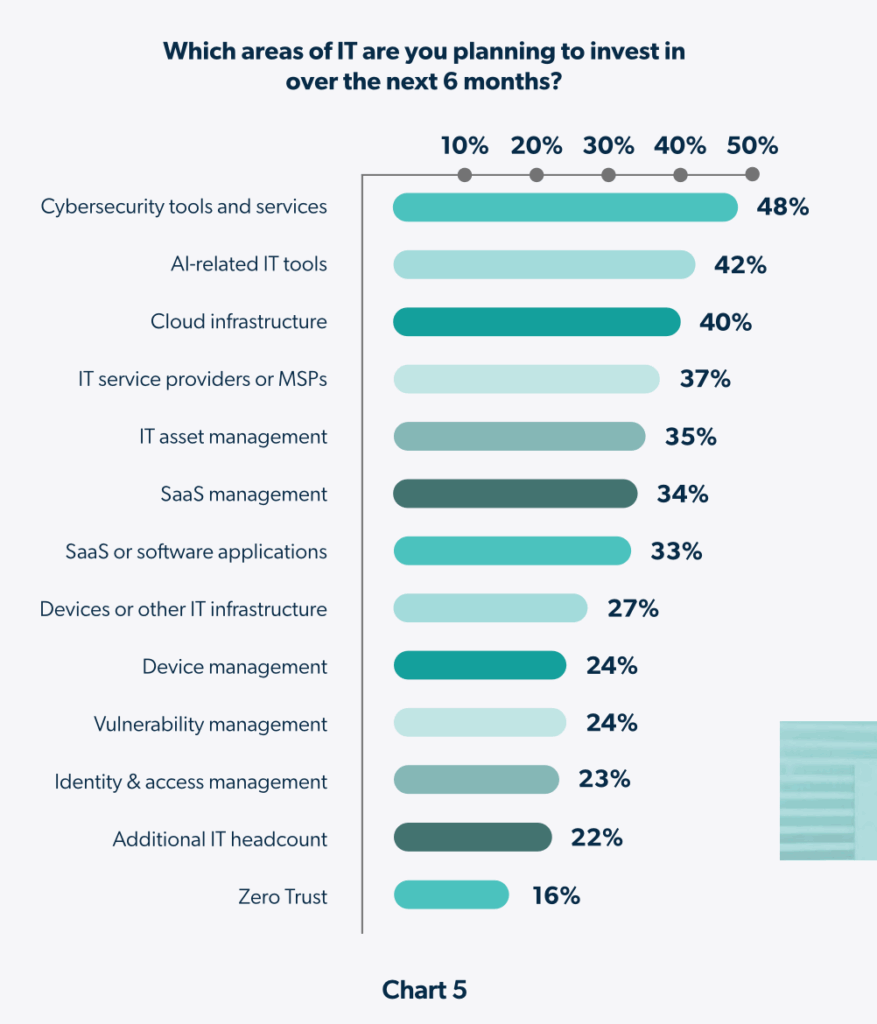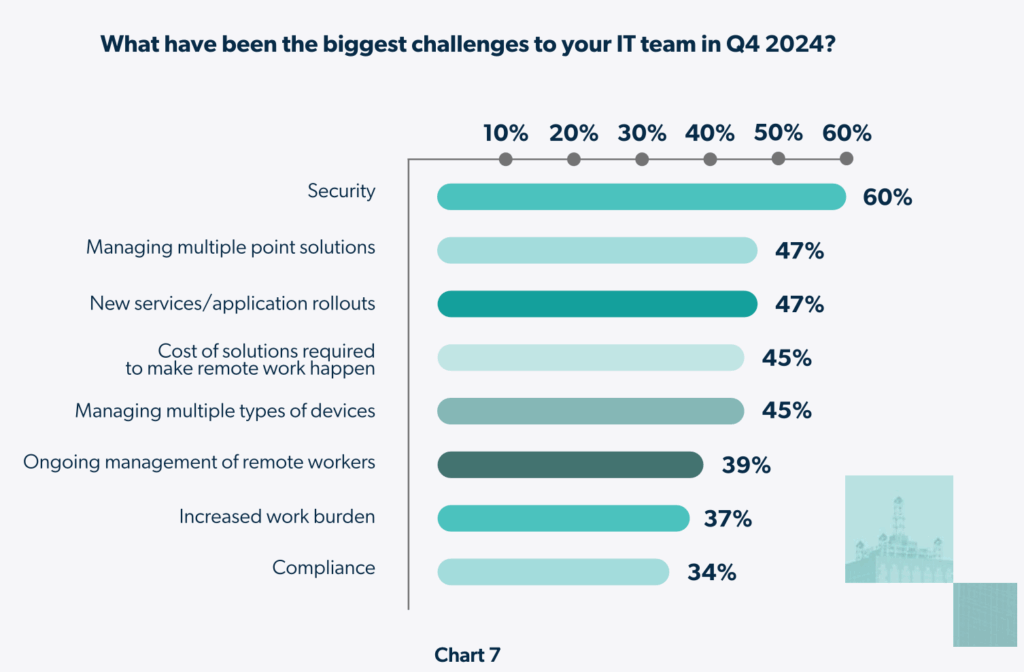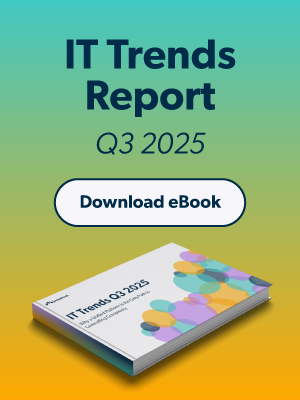Digital transformation is speeding up like never before, thanks to connected devices, cloud applications, and the growing power of artificial intelligence (AI).
While all this innovation is exciting, it also brings more risks. That’s why so many organizations like yours are turning to automation — not just to handle repetitive tasks, but to cut risks, boost productivity, and improve security.
Automation isn’t merely a substitution for human effort; it represents a fundamental shift in how organizations approach efficiency, productivity, and innovation. It helps you simplify your day-to-day, giving you more time to focus on big-picture, strategic goals. Automation is not optional anymore if you want your organization to actually succeed.
In this blog, we’ll dive into why IT automation is so important, how it’s evolving, what the latest statistics reveal, and where the biggest challenges and opportunities lie. Keep reading to gain valuable insights that’ll help strengthen your team and build a better roadmap for 2025 and beyond.
Why Automation Is Crucial Nowadays
IT teams are navigating a perfect storm of complexity. Cloud environments have become sprawling, multi-device ecosystems are harder to manage, and cybersecurity risks are evolving faster than many teams can react.
On top of that, most (90%) of IT leaders are worried about shadow IT, as employees continue turning to unauthorized tools to get work done.
This kind of environment demands automation. Manual processes simply can’t keep up with the scale and speed of today’s IT needs. That’s why forward-thinking organizations are embracing automation to streamline operations, improve visibility, and reduce risk.

Whether it’s consolidating toolsets, accelerating patching, or automating user provisioning, automation is helping IT teams cut through noise and stay in control. It also enables faster service delivery and a better end-user experience, which is critical in hybrid or remote-first environments.
IT Automation Statistics: Editor’s Top Picks
These statistics highlight just how fast IT automation is evolving — and why it’s becoming a must-have for any organization looking to scale, secure, and simplify ops:
- Most (85%) IT admins want a single platform to manage devices, identities, and access.
- Global hyperautomation spending is expected to top $600 billion in 2025, growing 15% year-over-year.
- Microsoft Power Automate users report a 199% return on investment (ROI) over the last three years, along with 27% fewer errors in their processes.
- Employees estimate automation can save them 240 hours per year, while leadership puts the number closer to 360 hours.
- Google’s AI pilot program delivered 122 hours of time savings per employee annually on administrative tasks alone.
- Organizations leveraging fully automated security processes save an average of $3.05 million per data breach.
- By 2027, employers expect that 42% of manual or physical tasks will be automated. .
Automation is reshaping every layer of IT at speed and scale, and these numbers say it all.
How IT Automation Is Transforming Operations
IT leaders are redesigning operations to run on automation-first principles. The market is following suit:
- Automation testing revenue is projected to hit $36.7 billion in 2025.
- Security automation tooling already tops $12.1 billion, forecasted to reach $39.6 billion by 2034.
Why the acceleration?
- Redesigning workflows around automation can slash operating costs by up to 30%.
- Nearly half (42%) of organizations plan to purchase AI-driven IT tools in the next six months, and 77% expect to within a year.
- Almost a quarter (18%) of organizations still use eleven or more disconnected IT tools, creating friction and inefficiency.

- Low-code tools like Power Automate deliver hard-dollar ROI, reduce errors, and achieve payback in under six months.
This shows that IT leaders are aligning automation with strategy, and not just tools — moving from reactive IT to proactive impact.
The Human Impact of IT Automation
By offloading repetitive tasks, teams can focus on the kind of work that drives growth:
- Automation offers a time dividend. Studies show staff could reclaim between 240 and 360 hours each year, spent on more rewarding projects.
- Google’s UK AI Works have already banked significant time savings and delivered economy-wide advantages.
- Many (66%) DevOps teams now consider workflow automation a core responsibility.
- Nearly half (47%) of IT admins see eliminating tool sprawl as their ticket to higher-impact work.
When automation handles routine patches, account provisioning, and ticket triage, IT can better focus on architecture, innovation, and transformation.
Security and Automation: Why They Go Hand in Hand

Cybersecurity is the top reason many organizations are doubling down on automation. The threat landscape keeps expanding, and IT can’t afford slow, manual responses:
- Organizations with advanced security automation cut breach response time by over 100 days and save $3.05 million per incident.
- Still, only 30% of IT teams patch critical operating system vulnerabilities within hours. Automation is the answer to shrinking this dangerous window.
- Security tools account for the highest share of IT spending across most mid-sized organizations.
- Shadow IT remains a serious issue. Although IT is investing in automation to track unapproved apps, 38% admit they lack automated discovery tools.
This proves that automation is one of the most impactful investments your organization can make.
Automation, the Cloud, and GenAI
As cloud adoption surges, so does the complexity of managing it all. With 40% of IT budgets going to cloud infrastructure, optimization is critical. Automation makes the cloud manageable and cost-effective:
- Automated cloud ops drive double-digit TCO savings, especially after migration.
- Continuous provisioning, policy enforcement, and compliance checks close audit gaps and boost agility.
- Infrastructure-as-code (IaC) scanning tools “bake in” security and consistency.
- Almost all (95%) organizations are exploring generative AI (GenAI) for cloud management, with 40% already deploying it and 30% starting this year.
The push here is about turning the cloud into a self-healing, self-optimizing platform that can scale without breaking.
Ethics and the Evolving Workforce
Each advance in automation inevitably raises human concerns, a narrative interwoven with both hope and apprehension:
- The World Economic Forum predicts 42% of manual tasks will be automated by 2027, affecting nearly 1 in 4 jobs.
- Nearly 40% of workers worry about job security due to AI. Yet paradoxically, many organizations are increasing hiring, especially in cybersecurity and automation management.
- Roughly half (49%) of organizations have formal GenAI policies — leaving a remarkable segment flying blind.
- Experts predict AI could unlock an extra 12 hours per week, per employee, but only with investment in training and upskilling.
The smart move? Use automation to elevate your teams, not replace them. Organizations that invest in ethical governance and continuous learning will build trust and a future-ready workforce.
Make JumpCloud Your Ally In Conquering the IT Landscape
Manual processes are a liability. Every spreadsheet you still reconcile, every unpatched system you babysit, every ticket routed by hand — that’s lost time, added risk, and untapped potential.
If 2024 was a trial run, this is the year IT leaders either scale with automation or fall behind. The cost of falling behind is no longer limited to inefficiency. It now includes wasted budgets, employee burnout, and increased exposure to security breaches.
Your organization thrives when you:
- Turn repeatable IT processes into scalable, secure workflows.
- Consolidate fragmented tools into a unified platform built for control and clarity.
- Treat automation as a strategic pillar and not a one-off project.
- Invest in your people, freeing them to focus on innovation and offering clear reskilling paths.
- Prioritize governance and ethics from day one, building trust while building tech.
Simplified IT begins with an ally you can trust. Explore JumpCloud’s 2025 SME IT Trends report for more insights on streamlining operations, strengthening security, and scaling your organization with ease.




